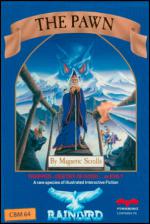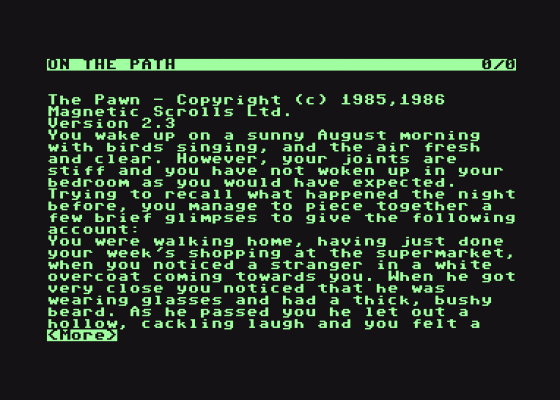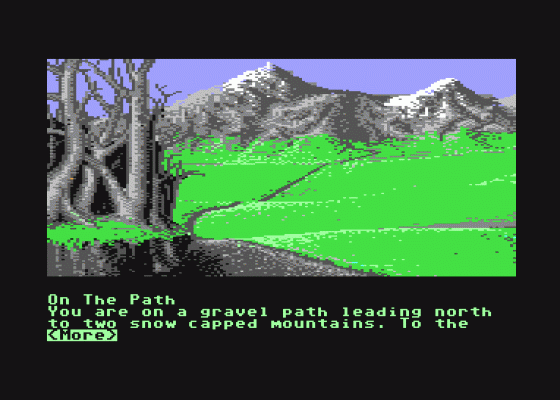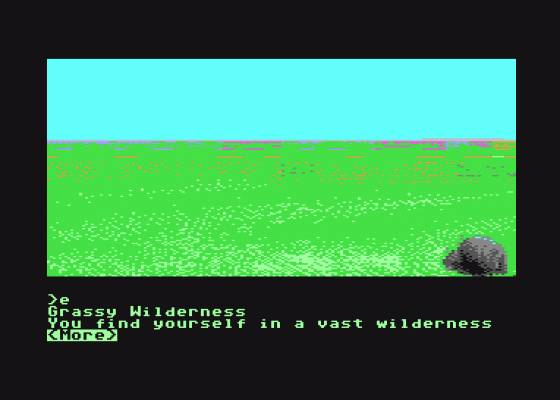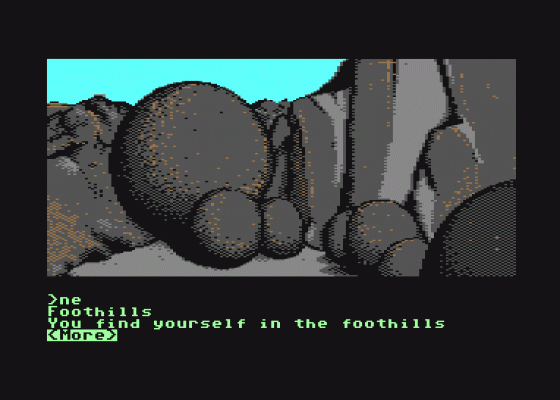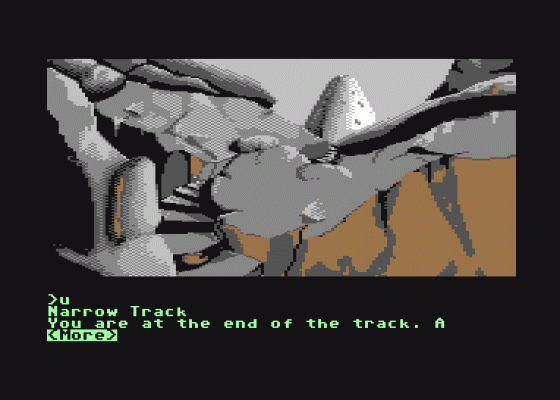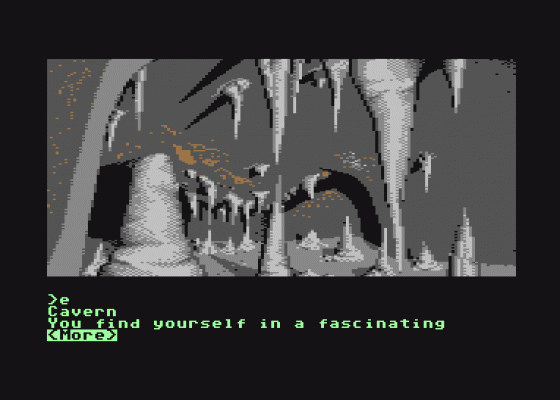
C&VG
 1st April 1986
1st April 1986
Categories: Review: Software
Publisher: Rainbird
Machine: Commodore 64
Published in Computer & Video Games #54
The Pawn
What's this? Keith Campbell raving about a graphic adventure. No, it can't be! In this exclusive C&VG preview, Keith tells you about the most amazing adventure he has ever seen. It's called The Pawn, it's being released onto an unsuspecting world by Rainbird Software. Read on and be amazed...
If you were playing a text-only version of The Pawn, you could be forgiven for thinking that this was another Infocom adventure. It's not that Magnetic Scrolls have "lifted" Infocom's technique - they have developed a system of their own, that in most respects is superior.
The Pawn has a rich plot, devised by Rob Steggles, a philosophy student. There is painstaking detail in the text, and a wonderful sense of humour throughout.
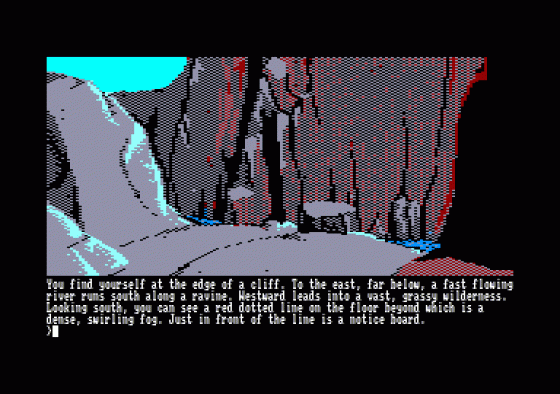
The King of Kerovnia is losing his grip, and no longer commands the loyalty and devotion of his subjects that he once enjoyed. The pundits attribute this to King Erik's refusal to reinstate citizenship to the Roobikyoub dwarves, who were thought to be the instigators of the assessination of Queen Jendah II. The dwarves were banished by Erik, but the true facts of the assassination were never discovered...
Kerovnia's economy once thrived, due mainly to the relentless effort of the dwarves in producing the strongest malt whisky this side of the Obakanga. But vested interests are not at work to prevent the return of the dwarves, in the form of the Farthington Real Ale company, and the Romni gnomes, producers of a refreshing spring water - at least as good as Perrier!
This is the situation in which you arrive, and your exact mission, and how to set about accomplishing it, are the first of your worries!

I set off innocently enough along a gravel path in the forest, and soon things began to happen:
"Kronce the magician zooms past on a circular stone platform that hovers above the ground, executes a steep banked turn, and glides to a halt in front of you."
Imaginative stuff, indeed! But should I undertake his task?
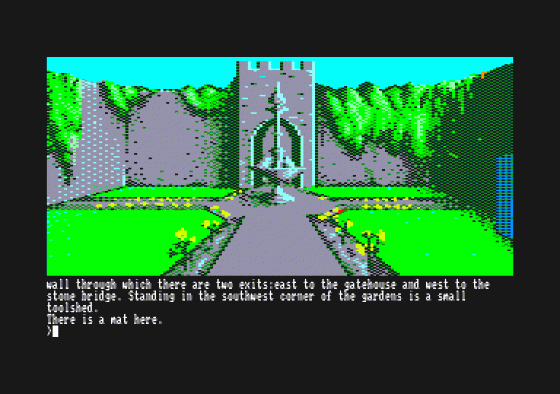
I decided to accept, and not having the slightest idea of my whereabouts, set about exploring the land. Before long I found myself in the company of a guru, who took one long at me and fell about laughing.
I have myself a quick check - no, I was fully dressed, so what did he find so hilarious? I asked him, and he was shaking so much with mirth, it was all he could do to point to a silver band on my wrist.
Being a generous sort, I thought I'd give it to him - perhaps I could turn the tables on him and get a laugh out of it myself! Aha! Nasty problem number one. The wristband won't come off! What the hell is it for?
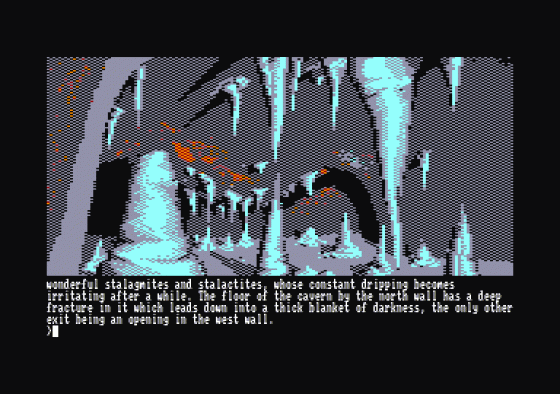
All commands I tried were fully covered, and with even more detail than I would have expected. Wondering if there was anything in my jeans' pocket, I typed: EXAMINE POCKET. The answers went like this: "It is a loose bag inserted into the..." My fault for asking!
If The Pawn is to be the first of a series, and the series is produced with no alterations to text or parser for the more popular micros, then it will not be long before the standard of software demanded by adventure players will rocket.
No longer will it be viable to knock out a quick cheap-and-nasty on The Quill. People will be more willing to pay about £20 for something to which they will thrill rather than waste a fiver on a sparse screen offering little for the imagination to bite on.

The Pawn is so good that to compare it in the same category as many of the adventures currently on the market is to do it a gross injustice. Good luck to Magnetic Scrolls and Rainbird in their bid to raise standards. They deserve it.
Production
Graphic adventures may sell more copies than text-only adventures, but ask any real adventure enthusiast which he prefers, and the answer will always be text, with a captial 'T'.
Well-written, detailed text gives an adventure game more interest and depth. Something that the player can settle down to, just like a good book.
Graphics in cassette adventures are generally held to occupy memory better used for plot and text. In disc, games graphics tend to slow response times down to an almost unacceptable level.
With the continual advances in hardware technology more and more memory becomes available to home computer owners at prices they can afford. And as that happens the format and graphics/text mix of adventure games can evolve.
I got a glimpse of the shape of adventures to come when I visited the London HQ of Rainbird Software where I met Anita Sinclair from Magnetic Scrolls, the design team behind the magic which makes The Pawn so special.
When I arrived the Atari ST monitor was showing a graphic display that I first though was a photograph. It turned out to be the loading screen of the game!
To produce a photo-like picture on a monitor requires literally hundreds of different colours in order to obtain the fine gradation of tone produced by the lighting. In fact, this picture used over 500 colours, although the ST can only manage sixteen.
"This is the title screen," explained Anita. "And it is an exact copy of the picture on the game packaging." This is only one picture like this in the whole game as it requires 80% of the processor power to maintain the picture on the screen!"
Although the other graphics within the game aren't so detailed they are still the most advanced and impressive pictures even seen in an adventure game. You'll get a good idea from the screen shots on this page!
Drawn by artist Geoff Quilley, each picture took about three days to complete. The adventure has over 100 locations, but there is only enough room on the disk for 35 pictures on top of the 96K program.
Anita started the game proper, and after a screen full of introductory text had unfolded, a picture slid down over it from the top of the screen.
We appeared to be in a walled garden with a fountain in the middle, and the sun was shining from the right. A shadow fell across part of the wall, following the contours of the greenery hanging from the top of the wall. Where the light hit other parts of the wall, individual bricks stood out, reflecting different colours.
"The picture came too quickly. I missed that text!" I grunted. Taking hold of the 'mouse' connected to the computer, Anita rolled it away from her, and the picture slid back up just like a roller blind, revealing the text once more.
Bringing the mouse back and forth a few times, Anita idly slid the picture up and down, eventually leaving it about half way up the screen.
I deliberately said "like a roller blind". Just think about that for a moment. The mouse didn't erase upwards from the bottom of the picture. Nor on its first appearance did the picture 'scroll' down from the top.
What was happening was that the top of the picture was being pushed upwards off the top of the screen, and being pulled back down by the bottom.
At the bottom of wherever the picture had been left, hung four tags, labelled FILES, TEXT, GRAPHICS and COLOUR. By moving an on-screen arrow on top of one of these, Anita used the mouse to pull down the tab marked TEXT. This revealed three words: NORMAL, BRIEF and VERBOSE. These were word-icons, and could be selected as a command through the mouse, before being slid back up, out of the way.
"Hmm, those are commands normally used in Infocom-style games..." I muttered. "That's what I really wanted you to see," Anita replied. "They seem sensible standard words," and she continued on into the adventure.
The outpourings of text, together with a fiendish sense of humour, and a devious plot, showed this adventure to be every bit as good as the best of Infocom, the last thing I had expected to see on this assignment!
"Better than Infocom!" corrected Anita. "Watch! And so saying, we went off to find a tree stump, taking with us a top hat, a pointy hat, two bottles (one green and one brown) and a key.
"The stump is hollow, yet it is thick enough to sit on, or to place things on," explained Anita. She then proceeded to put the top hat IN the stump, and the pointy hat ON the stump, following this with the command: PUT GREEN BOTTLE IN HAT IN STUMP AND BROWN BOTTLE IN HAT ON STUMP. The parser had no problem dealing with that tongue twister!
The parser is the program module that interprets the player's input, decides what the player means, and acts accordingly. It is the intelligence working away behind the scenes.
Magnetic Scrolls call their parser Eliza, but in fact it is not a true Eliza parser, I was told. "It carries out what we call 'context-free parsing'," said Anita.
"We're not finished yet," Anita continued attempting the command: PUT KEY IN BOTTLE IN HAT IN STUMP. "Wow!" I exclaimed. "Hang on!" she replied. "Now I'm going to shift the key from one bottle to the other!" And so saying, she did: PUT KEY IN BOTTLE IN HAT IN STUMP IN BOTTLE IN HAT ON STUMP.
"That sort of parsing lends itself to the construction of some pretty amazing puzzles!" she smiled, slyly! "We can nest things 25-deep in that way."
For another demonstration, we wandered off into the potting shed. Here was a pot, and a plant. PLANT POT PLANT IN PLANT POT was recognised, and rewarded us with the reply: "The plant is much happier now", even though the word PLANT had been used as a verb, a noun, and an adjective!
A nearby barrow contained a number of items, including a pair of jeans, which when examined were shown to have a pocket. PUT ALL IN BARROW IN POCKET. This didn't work fully, for halfway through replying, came the response STRANGE CONCEPT - another Infocom favourite!
"Aha!" I smiled. "Caught it out at last!" Anita remained unpeturbed. "Not at all! The program is intelligent enough to know that it is not possible to put a pair of jeans into its own pocket!"
Incidentally, not only can long and complex commands be entered, but there is an on-board word processor, which allows slick editing. This varies according to the computer used, but on the ST, the previous command can be recalled into the input area, for manipulation.
The parser has been developed by a team of three people working a total of two man-years. It is Anita's pride and joy, and her enthusiasm shows! "We thought it was going to cop out when we asked an expert in artificial intelligence to try it, and he typed: I THINK THEREFORE I AM. The parser went away from quite some time, but to our delight and surprise, it eventually replied: OH, DO YOU?"
As well as the Atari ST, similar format graphics versions will be released for the Amiga, and the Macintosh.
"The Amiga was supposed to be the machine that would give us the best version, but in the end, the Atari beat it hands down," claimed Anita.
For monochrome players, there are some special graphics options, controlled by the scrolling icon. The pictures can be displayed using STIPPLE, FREEHAND or DITHER. It is difficult to explain what effect these commands have, but basically, they alter the way in which the colour pictures appear in black and white.
For those with a less exotic micro than the ST, Mac or Maiga, there will be still be a chance to play The Pawn.
It is already available in text only on the QL, published by Sinclair. The text and parser are identical to the ST version.
Rainbird will be releasing versions for the Apple II and Atari 800, possibly with graphics, but not of the same style. There will be versions for the Commodore 64 and Amstrad range, probably without graphics and the BBC in text only. All will be on disk, and releases are expected around June.
Infocom is probably the most respected company in the world for the quality and entertainment value of its adventures. Its games consistently ride high in the American charts, and rightly so.
Anita, a self-confessed adventure freak who got hooked playing Zork, and for whom an adventure holds little interest if it isn't from Infocom, told me she was asked by a close freidn what she would like for Christmas. "Give me Infocom!" she joked.
Given a series of games as brilliant as The Pawn, she will get her wish.
Other Reviews Of The Pawn For The Commodore 64
The Pawn (Magnetic Scrolls/Rainbird)
A review by The White Wizard (Zzap)
The Pawn (Rainbird)
A review by Gordon Hamlett (Computer Gamer)
The Pawn (Rainbird)
A review by Keith Campbell (C&VG)
The Pawn (Magnetic Scrolls)
A review by Keith Campbell (Commodore User)
The Pawn (Rainbird)
A review by Keith Campbell (Commodore User)
Scores
Amstrad CPC464 Version| Vocabulary | 99% |
| Atmosphere | 99% |
| Personal | 99% |
| Overall | 99% |
Scores
Commodore 64 Version| Vocabulary | 99% |
| Atmosphere | 99% |
| Personal | 99% |
| Overall | 99% |

